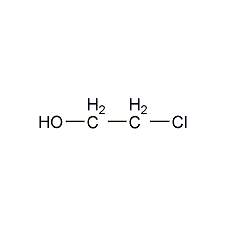
Structural formula
| Business number | 02UL |
|---|---|
| Molecular formula | C2H5ClO |
| Molecular weight | 80.51 |
| label |
Chlorohydrin, Ethylene chlorohydrin, 2-chloroethanol, 1-Chloro-2-hydroxyethane, 2-Chloroethyl alcohol, HOCH2CH2Cl, 1-Chloro-2-hydroxyethane, 2-Chloroethanol, 2-Chloro-1-ethanol, 2-Chloroethyl alcohol, Ethylene chlorohydrin, sugarcane germination accelerator, Multifunctional solvent |
Numbering system
CAS number:107-07-3
MDL number:MFCD00002829
EINECS number:203-459-7
RTECS number:KK0875000
BRN number:878139
PubChem ID:None
Physical property data
1. Properties: colorless and transparent liquid.
2. Boiling point (ºC, 101.3kPa): 128.8
3. Melting point (ºC): -67
4. Relative density (g/mL, 20/4ºC): 1.2007
5. Relative vapor density (g/mL, air=1): 2.78
6. Refractive index (n20ºC): 1.4421
7. Viscosity (mPa·s, 20ºC): 3.4
8. Flash point (ºC, opening): 60
9. Fire point (ºC): 425
10. Heat of evaporation (KJ/mol, b.p.): 41.45
11. Heat of fusion (KJ/mol): 1215.0
12. Heat of generation (KJ/mol , liquid): 294.3
13. Heat of combustion (KJ/mol, liquid): 1193.7
14. Lower explosion limit (%, V/V): 4.9
15. Explosion upper limit (%, V/V): 15.9
16. Vapor pressure (kPa, 30.3ºC): 1.33
17. Volume expansion coefficient (K-1,55ºC): 0.00092
18. Solubility: miscible with water, acetone, ether, slightly soluble in carbon tetrachloride and hydrocarbons.
19. Refractive index at room temperature (n25): 1.4401
20. Relative density (25℃, 4℃): 1.191230
21. The liquid phase standard claims heat (enthalpy) (kJ·mol-1): -294.1
Toxicological data
1. Acute toxicity: rat oral LD50: 95mg/kg; rabbit skin LD50: 67mg/kg
�Ethanol.

![]()
2. Refining method: 2-chloroethanol is composed of ethylene oxide and Prepared from aqueous solutions of hydrochloric acid or chlorine. Therefore contain small amounts of acid and ethylene oxide derivatives. During refining, use anhydrous sodium sulfate and anhydrous potassium carbonate to dehydrate, deacidify and then fractionate.
3.Use 32% industrial chloroethanol as raw material, use benzene for azeotropic distillation, further remove water, and then remove it by vacuum distillation The remaining benzene and
high boiling matter are removed to obtain the finished product.
4. In the presence of ferric chloride and sodium dihydrogen phosphate, anhydrous hydrogen chloride and ethylene oxide are directly added
to produce 2-chloroethanol with a content of more than 98%

Purpose
1. Used as a solvent for cellulose esters, coatings, resins, etc. It is also used in the manufacture of ethylene glycol, ethylene oxide, acrylonitrile, medicines, pesticides, dyes, etc. and as a sugarcane germination accelerator.
2. Used as a solvent for organic synthesis of dyes, pesticides, insecticides, etc.
3. Used in pharmaceuticals, tanning, synthetic surfactants, demulsifiers and emulsifiers, and can also produce ethylene oxide and ethylene glycol. It can be used as a solvent in liquid ink.


